IDEX Online Research: Strong US Demand Continues for Jewelry
October 15, 13
(IDEX Online) – Jewelry and watch sales in the U.S. totaled $5.64 billion in August, a 4.8 percent year-over-year increase, according to Department of Commerce figures. Due to the shutdown of U.S. government services, information about sales by specialty jewelers during the month is not currently available.
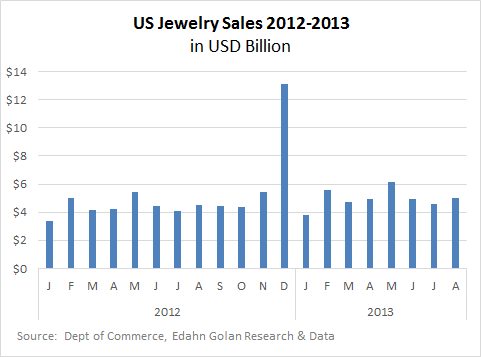
Total Jewelry Sales Continue to Grow
Jewelry sales alone, excluding watches, totaled $5.0 billion in August, rising 4.7 percent year-over-year. After maintaining sales increases of at least 6.5 percent year-over-year since November 2012, monthly jewelry sales fell below that level for the first time in July, and we note that this declining trend continued in August.
It is too early to know if the slowdown in growth indicates a possible change in direction after the strong performance that greatly outpaced the general U.S. economy, or if this is a short-lived situation. However, it is important to follow these changes and try to avert a further weakening.
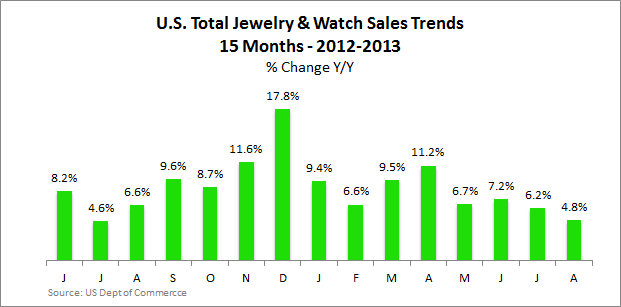
On a month-over-month basis, jewelry sales in August increased by a robust 8.3 percent, a cyclical trend. Historically, after decreasing in June and July, jewelry sales in the U.S. increase in August, as the following graph shows.
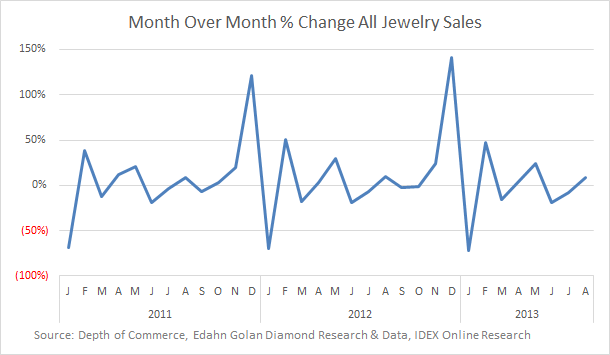
For the first eight months of 2013, jewelry sales are estimated to total $39.8 billion, up 7.4 percent year-over-year. In other words, despite the slowdown in growth, jewelry sales are still faring much better than during 2012.
Fine Watch Sales +5.5%
Watch sales in August increased by 5.5 percent on a year-over-year basis, totaling $662 million. Changes in watch sales trends are echoing those of jewelry sales. Here, too, the increase in watch sales softened in August for a second consecutive month compared to sales in 2012.
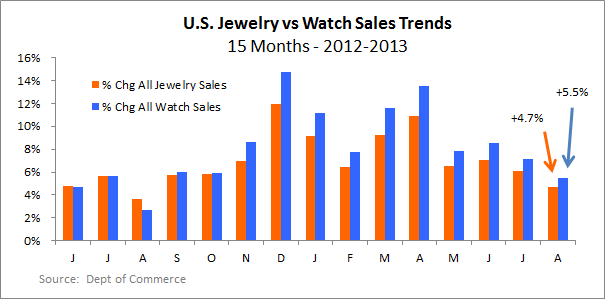
Month-over-month, watch sales increased by 7.9 percent in August. Once again, after the June-July decreases, sales increased in August as they typically do. If there is a reason for concern, it is that the increases in sales in August, compared to July, were larger in the past. In 2012, for example, the increase was 9.5 percent and in 2011, it was 9.1 percent.
Retailers should pay attention to this component of sales increases. Improving sales are, of course, desirable, however if they are slowly shrinking, it may be time to reconsider market positioning of jewelry and, with it, marketing efforts on their part.
Jewelry & Watch Spend
Overall, American consumers’ expenditure on jewelry and watches represents just a fraction of total expenditure. Annual expenditure in the U.S. economy exceeds $11 trillion, compared to annual jewelry and watch sales of less than $80 billion.
Spending on jewelry and watches is just shy of 0.7 percent of total consumer expenditure. This figure has been fairly consistent over the years, however due to the size of the U.S. market, tiny changes of a fraction of a percentage point represent large changes in how much of their budget Americans are willing to spend on jewelry in dollar terms.
After a decline in the aftermath of the 2008 crash, sales as a percentage of total expenditure have been growing since 2009, peaking at 0.70 percent in March 2013. Since then, spending on jewelry and watches is slowly weakening. In August 2013, it stood at 0.67 percent, based on seasonally adjusted annualized rates.
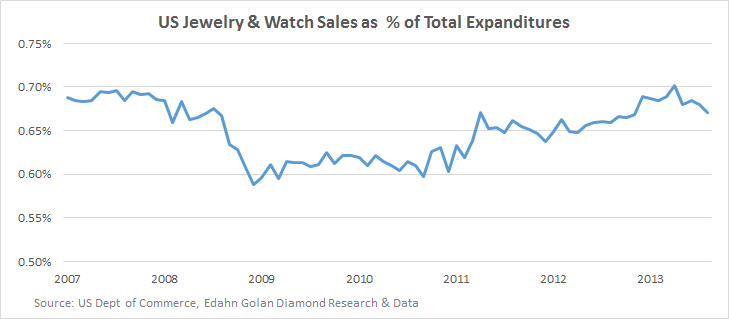
Outlook
American consumers are voting with their wallets – and showing an interest in jewelry in 2013. While we see a long-term growth trend, in the past few months this growth has been slowing. This is not a reason for concern, at least not yet. However, all sectors of the jewelry industry should pay attention to this change and ensure that they are ready for a shift in direction – if it indeed happens.
Meanwhile, we can take comfort in the knowledge that American consumers have not lost their appetite for jewelry, and opportunities are clearly still there for a wide variety of categories, including diamond jewelry.